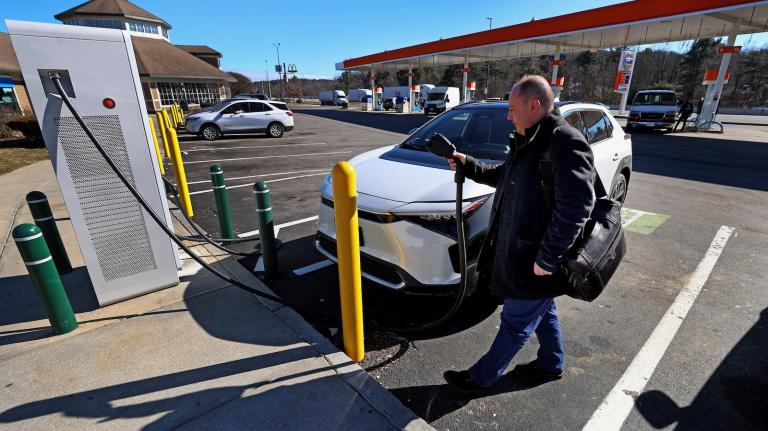It was a bad headline and a bad take on an important issue from a writer at a publication that ought to know better. Last week, M.J. Rosenberg, writing at TPM Cafe, penned a quick post entitled “Question for Paul Krugman: Why Does the DC Metro Suck?” In the space of a few short words, Rosenberg revealed that arguments in favor of increased public transit shouldn’t just be directed at environmentally negligent conservatives. There is a lot of work to be done winning over writers, voters, and leaders on the left as well.
The source of Rosenberg’s anger was a rough two-week period for Metro that affected morning commutes on some of the busiest lines into downtown Washington, D.C. (mine included). He writes:
Thank God for Paul Krugman. Reading his absolutely superb "The Conscience of a Liberal" while making my daily commute between Maryland and Capitol Hill, I almost failed to notice that every single train ride over the last two weeks has been a nightmare.
They have been so bad that I actually managed to read an entire 240+ page book in about five round trips (not bad, considering each trip is supposed to take less than a half hour).
Even with a delay, it’s unlikely Rosenberg could have arrived at his destination much more quickly by car — and had he driven downtown, he could have counted on paying $12 to $15 in parking fees. Were he a regular driver, he’d quickly learn that roadway delays are more common and capricious than delays on the Metro system. Drivers around D.C. never complain about a bad two-week period; every fortnight is terrible.
Had he been stuck in automobile traffic, he would have paid for the privilege of his idling engine to the tune of $3.20 per gallon, and while he might have been able to read his book, such behavior is generally frowned upon by highway patrolmen.
In short, Metro at its worst is still pretty good for commuters.
Every weekday, Metro handles some 725,000 trips in the D.C. area. Close to half of all Washingtonians commute via public transit, along with over a quarter of those in D.C.’s inner suburbs. As a result, transportation emissions per capita are well below the national average. A look at CO2 emissions (PDF) from transportation reveals that a resident of the District of Columbia will emit about a third as much as the average American. This is failure?
Were Rosenberg to abandon Metro, another rider would happily take his place. Nationwide, transit use is at its highest level since the Eisenhower administration, thanks to growing highway congestion and high gas prices. This growth has been reflected in the Washington area. According to a survey conducted by WMATA — the Metro transit agency — ridership has boomed over the last five years, led by increases in the District. Washingtonians took 17 percent more Metro trips this year than they did in 2002. Maryland ridership grew 8 percent in that time, and Virginia’s patronage grew by 4 percent. Clearly, local commuters don’t share Rosenberg’s hatred of the system.
Their confidence has also led to a regional boom in transit-oriented development. Growth around Metro stations has exploded in the past decade, which in turn has improved the ability of local commuters to get around without driving. A Washington Post story analyzed the WMATA survey mentioned earlier:
During the morning rush, more people are walking, taking a bus or biking to stations than did five years ago. Commuters hopping on a Metrobus or other local bus took 52,572 trips during a typical morning rush this past spring, a 26 percent increase from five years ago.
In Alexandria, almost 50 percent of morning rush-hour commuters took the bus to the rail station. In Arlington and the District, close to 70 percent of morning rush-hour riders walked to the train station.
Biking is also much more popular. Those who bike to a Metrorail station are still a tiny percentage of all riders, but they took 1,150 trips during a typical morning rush this past spring, a 60 percent increase from five years ago.
That’s a peculiar sort of “failure.”
Let’s be honest. Increased ridership has placed a strain on Metro, as it has on public transit systems around the country. Fuel costs and carbon abatement measures, along with congestion, will continue to drive new riders onto mass transit. This can only be seen as a great thing for the economy and the environment, but it heightens the need for more capacity and more funding for public transit. System maintenance, to say nothing of expansion, will become difficult if transit continues to absorb $1 of government spending for every $40 allocated to roads.
That’s why it’s vital for those who care about climate change to recognize what a success transit has been in this country. Even when funded poorly, transit systems have meaningfully reduced congestion and carbon emissions where they exist as transportation options. There are enough hack scientists and columnists out there spinning faulty arguments based on questionable statistics in an effort to undermine support for desperately needed investments in public transportation. We can’t have the good guys on the wrong side, too, missing the benefits of the Great Society success story that carries them to work every day.

